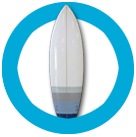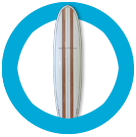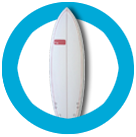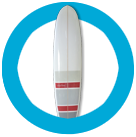 |
 |
 |
 |
 |
 |
HOW TO CHOOSE YOUR SURFBOARD
Choosing a surfboard can be quite daunting, with the vast array of different surfboards available on the market today. There are a few factors that you should consider when choosing the right board; they include your ability and the time you spend in the water. Then it comes down to the 4 basic elements of a surfboard.
1) SURFBOARD SHAPES
Picking the right shape is the key when learning to surf. It is actually really simple - learners need floatation + stability - and the bigger the board, the more floatation and stability!
The main shape that provides this is the minimal and longboard shapes. (Minimals are simply a shorter version of longboards). So for Adult this is the board shape of choice. Kids are lighter so can get away with a fish surfboard shape. Check out our descriptions of each surfboard type below.

SHORTBOARD - For Intermediate to Advanced
The traditional shortboard is the shape most people think of when they think of a surfboard. Pointy nose and refined shape. A shortboard might be classed as anything under around 6 foot 6 inches however the definition is not specific. e.g. for some a 6'3 is a "step-up" board for bigger waves and yet for other heavier guys a 6'6 is their choice for a shortboard.
Whatever the board size the meaning of shortboard is a board someone chooses for high performance surfing in small to medium waves.
The main reason shortboards are not good for learners is they are thin and unstable and made for accurate performance surfing. The opposite of what a beginner needs!
FISH SURFBOARDS - For Beginner to Advanced
Fish surfboards are designed to surf smaller waves. They are a similar outline to a shortboard but basically wider and thicker with less rocker (curve). They generally have a swallow tail design and a 2, 3 or 4 fin setup.
Fish used to be the summer board choice for advanced surfers but now many designs and the bigger fish boards are good for some people learning to surf. Fish allow learners to progress beyond the turning limitations of a mini-mal surfboard or a longboard. They are also popular with the "big boys" who want something to rip it up on and with kids who want to look cooler than carrying a minimal.
Intermediate to advanced surfers normally ride a fish that is up to 4-inches shorter than their normal surfboard.
Advantages
Fish surfboards are perfect for small waves. They move quickly over flat sections of the wave while you are surfing and are easy to maneuver. Fish ride really smooth, look great and are a must-have for any surfer who spends a lot of time in the water over summer!
Disadvantages
Fish surfboards don’t perform as well in bigger surf and tend to be quite loose. Quadfish surfboards are the fastest but can be slightly harder to turn. The experienced surfer will find they have to adapt their surfing style as they move from a quad back to a thruster setup.
See our Fish Surfboard Size Charts here
MINIMAL (FUNBOARD) - For Beginners to Intermediate
Mini-mal surfboards or funboards are perfect for the person who likes the feel of a longboard but wants more maneuverability. Minimals are easier to carry and manage out in the water but with all the surfing ease of a longboard. They therefore are the best board for learning to surf for kids and smaller adults. Advanced surfers can have fun on one of these on small surf days too!
See our minimal size charts here
LONGBOARDS - For Beginners to Advanced
The longboard or malibu surfboard is a modern replica of what the sport was started on. Paddle into what ever you want and hang ten all the way to the beach. Among the most popular boards in the water and for good reason - longboards are easy to start on and always fun.
See our longboard size charts here
SOFTBOARD - For Beginners only
Softboards are for kids or beginners to learn to surf on. The length and width of these soft boards are designed to maximise stability and make them easy to paddle on. The soft construction of the board ensures you don't get hurt during the spills while you still enjoy the thrills.
Softboards limit how far you can progress as they don't turn as well due to the soft fins. Mini-mal's are more popular for the serious learner surfer.
See our softboard size charts here
2) SURFBOARD LENGTH
The length of your surfboard is the key issue when choosing a surfboard. Basically because a longer board = more float which is going to make it easier to paddle and catch waves. If a board is too short for you it will make it exponentially harder to learn and slow your progress down dramatically. It is much faster to learn by starting on the right size board and then drop in size when you are ready.
Take a look at our size charts to get an idea about sizes that you should be looking for in your surfboard. Be sure to make the right choice when buying a board and if you are unsure send us an email and we will be happy to help.
Surfboard length is dependent on a few things:
ABILITY
Are you fit and coordinated? Someone with better water fitness and coordination can ride a slightly smaller board. Yes things like skateboarding and snowboarding help but most of the fitness is a new kind for your arms so be honest with yourself. You will learn quicker by not going too short too soon.
WATER TIME
A surfer who only surfs occasionally will need a bigger board than one who surfs regularly. This comes down to paddle fitness and balance. The more time you spend in the water, the more waves you will catch and less waves you will fall off. A board that is too small will hold back a surfer's improvement and probably result in frustration. It takes a long time to learn to surf and you can sell boards second hand so if in doubt it is best to go for something slightly larger - you will learn faster!
WEIGHT
Your weight is the key determinant of what length board you should choose, the tables below can be used as a general guide. If you feel you are water fit, coordinated or will get a lot of time at the beach go for the ower end of the suggested scale.
3) SURFBOARD CONSTRUCTION
Surfboards Direct carry all types of surfboards - Fibreglass, epoxy and softboard surfboards. No one type is better for learning. Construction is not important as shape and size. However each type has slightly different characteristics that might be important to your personal preference.
FIBREGLASS SURFBOARDS
This is your normal type of surfboard construction and the most popular. Machine shaped to absolute precision measurements and hand finished. These boards are most popular due to the attractive traditional gloss and matt finishes and the advantage of being easier/cheaper to fix in the future should you get any major dings.
EPOXY SURFBOARDS
Epoxy surfboards use polystyrene foam and epoxy resin. Epoxy surfboards are in general lighter. Some are stronger depending on the exact construction method. They are popular due to their ability to resist the smaller everyday dings. For kid's or females who are not as strong epoxy boards can make the larger boards easier to carry and handle. Surfboard Direct's epoxy boards are glassed using high quality epoxy resin and seamless rails. The finish on an epoxy board can be more "plastic" looking but they allow for brighter more vivid colours.
SOFTBOARDS or FOAM SURFBOARDS
Softboards are only for beginners and are a cost effective way to get your first experience of fun in the surf. They are safer and you can surf between the flags on a softboard. Softboards can either have a slick or foam bottom much like a boogie board construction. The fins are softer/rounder and made of stiff rubber so are less likely to cut you accidentally.
You do not need to wax your softboard as much because the foam itself is quite grippy. It is recommended that you wear a rashvest or wetsuit when using a softboard as they do tend to give you a rash more quickly than a regular surfboard due to the increased amount of friction.
Softboards are limited in their performance ability and because of the rubber fins are not actually very easy to turn and control. If you are serious about learning you should buy a fibreglass or epoxy mini-mal or longboard.
GENERAL GUIDE TO SURFBOARD LENGTHS - SIZE CHARTS
The following Surfboards Size Chart provides a general guide for choosing a surfboard. It links to catalogs displaying those specific sizes for you convenience. Navigate to the main menu to see all board sizes in each category:
Click on the links to see boards available to buy in those sizes
FISH SURFBOARD SIZE GUIDE
| Fish Surfboards |
MINI-MAL AND LONGBOARD SURFBOARD SIZE GUIDE
| Mini-mal / Longboard Surfboards |
SOFTBOARD SIZE GUIDE
| Softboards for Beginners |

 1/2 PRICE SHIPPING
1/2 PRICE SHIPPING




